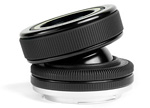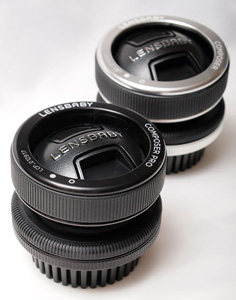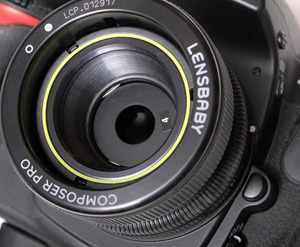CAPTURING BEAUTY
Lensbaby Composer
Turns Pro

By MIKE PASINI
Editor
The Imaging Resource Digital Photography Newsletter
Review Date: April 2011
You can't capture Beauty," the words floated on the air to me as I squinted into the viewfinder to set focus on the cherry blossoms above me.
Related Posts
I laughed but when I turned around, she'd gone as if to prove her point.
No, you can't capture Beauty, but the fun, after all, is chasing it. Especially when it slows down enough to get close enough to focus.
SELECTIVE FOCUS | Back to Contents
With a Lensbaby Composer, the fun can be a little richer because you can, depending on which optic you select, pick an area of your composition to limit focus. This selective focus feature is subtle at small apertures but pronounced at large ones.

Cousins. The Pro (front) and the original Composer.
Had my heckler been able to see what I was doing, she would have seen two subjects in my viewfinder. In the background was the reading room of Doe Library on the University of California at Berkeley campus. In the foreground were the cherry blossoms she thought I was focusing on.
But with the 50mm Double Glass Optic I was able to focus on either the building or the blossoms, narrowing focus by using larger apertures. And giving prominence to one subject in the composition over the other by selectively focusing on it changed the meaning of the image.
COMPOSER PRO | Back to Contents
I had the f/4 aperture disc in the Double Glass Optic so I had a pretty small circle of the whole frame in focus. The optic was installed in the new Composer Pro. By loosening the Pro's locking ring, I could swivel the front collar with the optic just as you would on the original Composer. Except on the Pro, swiveling is silky smooth thanks to its metal ball.
The Pro's front collar also sports an improvement over the original Composer with its refined focus mechanism. The original is certainly functional and holds its position but there's a bit of play in the mechanism. Once you nudge it, it stays nudged, but you can fiddle nervously back and forth a bit before it changes focus.
Not so on the Pro. It has no play and didn't develop any over several days of shooting. In the field, I took that for granted but when doing macro work with the 37mm Lensbaby macro lenses, it was a blessing.
OPTIC SWAP SYSTEM | Back to Contents
I shot a five-inch tall figurine of Pinocchio with the +10 macro lens on the Double Glass Optic. Using Live View and an f/2.8 aperture disk I was able to limit focus to just his nose in one shot and just his closest eye in another.

Double Glass Optic. Mounted in the Composer Pro with f/4 aperture disc.
I also used the Fish-Eye Optic with the Composer Pro. With a nearby subject, the fluid focusing mechanism of the Pro greatly enhanced the experience of composing the image. It made focusing feel as precise as safe cracking.
TWO CONFIGURATIONS | Back to Contents
Lensbaby plans to offer the Composer Pro in two configurations. You can currently get it for $300 with the Double Glass Optic, which includes aperture discs from f/2 to f/22. The Composer Pro will also be available for $400 with the recently announced Sweet 35 optic, a 35mm lens with a 12-blade internal aperture. That's a nice way to add both the Pro and the Sweet 35 to your collection.
And the original will still be available but for just $250 with the Double Glass Optic.
Either Pro configuration can also the other optics in the Optic Pro system, including the Fish-Eye, Soft Focus, Pinhole/Zone, Single Glass and Plastic optics.
The Composer Pro with Double Glass Optic ships with:
- The all-black Composer Pro in a specific dSLR mount
- Double Glass Optic mounted in the Pro
- Lens cap
- Black fabric carrying bag
- Aperture tool and disc carrying case
- Aperture discs: f/2.8, f/4, f/5.6, f/8, f/11, f16, and f/22.
- Instruction sheet
See our news story for more information.
There are no electronic contacts on the Lensbaby, so your camera can't tell what aperture has been set. But you do have control over the aperture, so you simply have to set your dSLR to Aperture Priority mode and let the camera set the shutter speed for the right exposure.
Alternately, you can shoot in Manual mode, controlling both the aperture (using the disks) and the shutter speed (using the camera controls).
I shot my cherry blossom images with the f/4 disc and the camera in Aperture Priority mode. The Tilden images were taken with an f/4 disc in Manual mode. The Pinocchio shots were taken with flash in Manual mode with an f/2.8 disc.
CAPTURING VICTORY | Back to Contents
I continued my walk through the Berkeley campus to take a few shots of Douglas Tilden's statue "The Football Players." Commissioned by San Francisco Mayor James Phelan to be awarded to the first team to win the Big Game between Stanford and Cal two years in a row, it depicts two players, the victor and the vanquished.
But paying "the price of victory," as Tilden saw it, the victor is on his knees bandaging the vanquished, who holds the ball. So the pose is a conventional one of one figuring towering over a bent one, but the characters are reversed.
That's a little like what the Composer lets you achieve, directing focus from the conventional subject (say, the cherry blossoms in the foreground) to the subject you want to emphasize (the majestic reading room). Here I set focus on each figure in the statue, making two quite different statements.
Did I capture Beauty? I'm not one to capture and tell. But I did enjoy the pursuit a little more with the new Composer Pro.